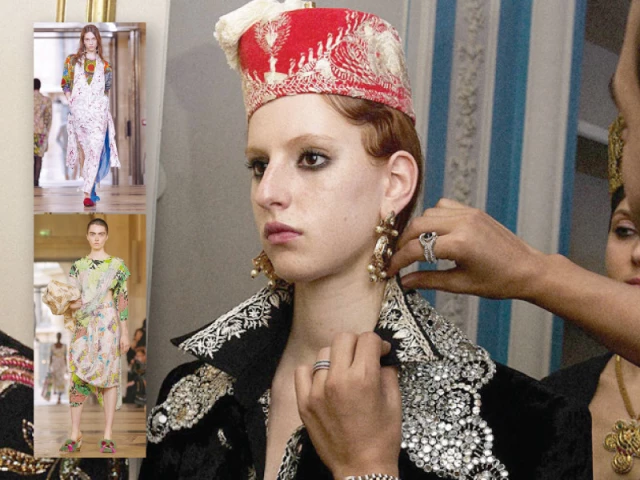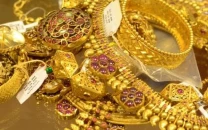Has Paris gone Desi?
Hussain Rehar leads a South Asian takeover of Paris Fashion Week

Paris Fashion Week has long been the citadel of haute couture, a place where style and spectacle meet under the glittering chandeliers of historic salons. But this season, the City of Lights shimmered with something different - the unmistakable glint of South Asian glamour.
At the heart of it all was Pakistani designer Hussain Rehar, whose Spring-Summer 2026 collection, Jeevan, turned heads at Hotel de Maisons, bringing the vibrant pulse of Lahore to Parisian runways.
Rehar's showcase wasn't merely a fashion moment - it was a cultural statement stitched in sequins and sentiment. The designer presented a line that danced between tradition and rebellion: coats and skirts in white, black, and crimson, adorned with rich embroidery, floral motifs, and sheer net overlays.
The pieces were styled with layered jewellery, textured hats, and smouldering eyes - a master class in merging Subcontinental opulence with Western poise. According to the brand, Jeevan celebrates "the spirit of the bold and charismatic individual".
It redefines contemporary fashion by fusing "dynamic aesthetics with the luxuriant heritage of South Asia". The result was a collection that shimmered with the allure of sparkle, the elegance of sequins, and the audacity of design that refuses to be boxed in.
Rehar, who established his namesake label in 2017 after graduating from the Pakistan Institute of Fashion and Design, has carved a reputation for daring yet sophisticated fashion. His archive includes resort wear, formals, semi-formals, and two bridal collections, all known for their meticulous craftsmanship and unapologetic glamour.
Rehar is now claiming a global stage that once seemed out of reach for many Pakistani designers. However, his moment in Paris is not an isolated triumph. It marks a wider shift - the slow but steady infiltration of South Asian aesthetics into global fashion capitals.
"Paris just got a heavy dose of Desi drama, and the fashion world may never be the same again," says a report on the Pakistan TV Digital. From shalwars strutting down the runway to prints borrowed straight from grandma's old trunk, the South Asian flair has found a home among Europe's elite.
What once might have been called fusion is now a full-fledged takeover. The French capital witnessed silhouettes inspired by the Subcontinent's timeless tailoring - voluminous shalwars, sari-inspired drapes, and embroidery that spoke a language older than the Eiffel Tower itself.
Designers across the board embraced this playful nostalgia, celebrating cultural roots with a modern wink. "Think luxury meets Lahore, couture meets Karachi, and Paris falling head over heels for the rhythm of the rickshaw," Pakistan TV Digital aptly remarked.
Forget stiff collars and muted palettes; this season belonged to colour, comfort, and cultural memory. The shalwar, long dismissed as casual homewear, strutted down the catwalk like it owned the place. And if anyone doubted that Desi fashion could hold its own in the global arena, the proof was in the Parisian applause.
Rehar's collection - along with the broader wave of South Asian influence - left a mark not through mimicry, but through authenticity. While some designers merely flirted with the idea of "ethnic chic," others, like Rehar, wore it proudly, rooted in heritage and unapologetically modern.
This South Asian moment in Paris has not gone unnoticed. From Zain Ahmed's Rastah - previously seen on Justin Bieber - to Doja Cat carrying a WARP handbag to her listening party, Pakistani design is no longer a regional curiosity. It's a global conversation.
Rehar's Paris debut cements that dialogue - one where Lahore's ateliers and Paris's runways speak the same language of artistry and ambition. But of course, the Parisian embrace of Desi fashion comes with its share of irony. As Pakistan TV Digital quipped, "Fashion, darling, is borrowing our look with a wink and a smile."
From Paul Smith's infamous £300 sandal that looked suspiciously like a £4 Peshawari chappal, to runway prints every South Asian girl recognises from her childhood wardrobe, the West's newfound "innovation" is often a nostalgic rehash of the subcontinent's everyday attire.
Still, there's hope that this fascination can evolve into genuine collaboration. Pakistan TV Digital gave credit where it was due: "Stella Jean gets a gold star for actually collaborating with Bhutanese artisans. The rest? It's a copy-fest we're highlighting with all the subtlety of a Bollywood dance number."
For Hussain Rehar, however, collaboration is built into the fabric of his work. His designs reflect not only technical skill but an instinctive understanding of how cultural narratives shape fashion. Jeevan is both personal and universal - a reflection of the South Asian experience in a global world.
Paris Fashion Week, this year, wasn't just a series of shows; it was a shifting of fashion's moral compass. South Asian artistry no longer plays supporting act - it headlines. As Pakistan TV Digital summed up with flair, "Dear designers: next time, try more collaboration! Your runway could use some authentic Desi magic – handlebar moustaches optional, but highly encouraged!"





















COMMENTS
Comments are moderated and generally will be posted if they are on-topic and not abusive.
For more information, please see our Comments FAQ